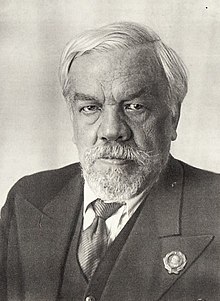This article needs additional citations for verification. (January 2024) |
Sergey Alekseyevich Chaplygin | |
|---|---|
 | |
| Born | 5 April 1869 Ranenburg, Russian Empire |
| Died | 8 October 1942 (aged 73) Novosibirsk, Soviet Union |
| Nationality | Russian |
| Alma mater | Moscow University |
| Known for | mechanics |
| Awards | Hero of Socialist Labour (1941) Orders of Lenin (1933, 1941) Order of the Red Banner of Labour (1927,?) Zhukovsky Prize (1925) |
| Scientific career | |
| Fields | Mechanical |
| Institutions | TsAGI, Moscow University, etc. |
| Doctoral advisor | Nikolay Zhukovsky |
| Doctoral students | Nikolai Kochin |
Sergey Alexeyevich Chaplygin (Russian: Серге́й Алексе́евич Чаплы́гин; 5 April 1869 – 8 October 1942) was a Russian and Soviet physicist, mathematician, and mechanical engineer. He is known for mathematical formulas such as Chaplygin's equation and for a hypothetical substance in cosmology called Chaplygin gas, named after him.[1]
He graduated in 1890 from Moscow University, and later became a professor. He taught mechanical engineering at Moscow Higher Courses for Women in 1901, and of applied mathematics at Moscow School of Technology, 1903. He was appointed Director of the courses in 1905. Leonid I. Sedov was one of his students.
Chaplygin's theories were greatly inspired by N. Ye. Zhukovsky, who founded the Central Institute of Aerodynamics. His early research focused on hydromechanics. His "Collected Works", consisting of 4 volumes, were published in 1948.[1]
- ^ a b "Sergei Alekseevich Chaplygin - Biography". Maths History. Retrieved 25 January 2024.